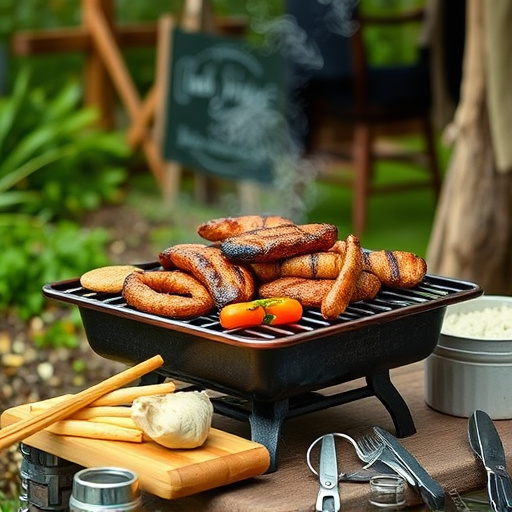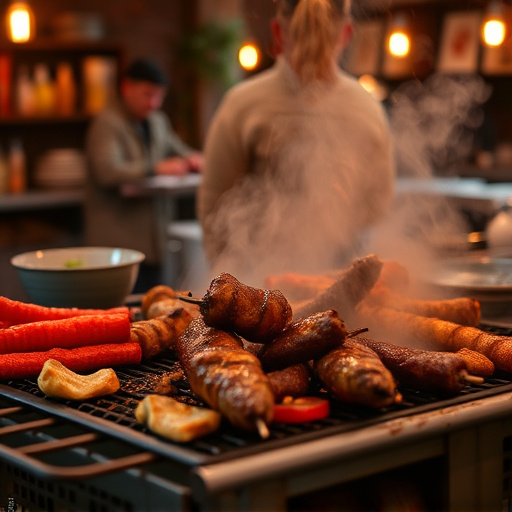Smoked BBQ Brisket requires careful selection, specific cutting, and meticulous cooking techniques. The key lies in choosing marbled meat with a balanced fat distribution, understanding the point-flat distinction for even cooking, and mastering low-and-slow smoking at around 225°F (107°C) to achieve a crispy bark and tender interior. A simple dry rub of salt, pepper, garlic powder, onion powder, and paprika enhances flavors. Strategic fire management, including consistent heat maintenance, regular fuel adjustments, and wood chip additions, ensures even smoking. Resting the brisket before slicing it against the grain, serving on a wooden board with complementary sides, and pairing with balanced beverages completes the perfect Smoked BBQ Brisket Recipe.
Unleash the ultimate culinary experience with a traditional smoked BBQ brisket recipe. This hearty cut of beef, known for its tender texture and rich flavor, becomes a masterpiece when prepared correctly. From understanding the cut’s importance to mastering smoking techniques, this guide takes you on a journey to create a crispy-barked, mouthwatering brisket. Discover the secrets to fire management, slow cooking, and seasoning for a dish that will impress even the pickiest of BBQ enthusiasts.
- Understanding Brisket: The Cut and Its Importance
- Dry Rub Seasoning: Crafting the Classic BBQ Blend
- Smoking Techniques: Achieving the Perfect Bark
- Fire Management: Controlling Heat for Tender Meat
- Slow Cooking: The Art of Smoking Brisket
- Testing for Doneness: Ensuring the Optimal Flavor
- Slicing and Serving: Presenting Your Masterpiece
- Pairing Suggestions: Accompanying Your BBQ Brisket
Understanding Brisket: The Cut and Its Importance

Brisket, often referred to as the “crown jewel” of smoked BBQ, is a cut of meat from the breast or upper chest of a cow. Its flat shape and thick muscle fibers make it a challenge to cook evenly, but also contribute to its rich, complex flavor when prepared correctly. When choosing your brisket for a smoked BBQ recipe, look for a well-marbled piece with good fat distribution—this is key to achieving that crispy bark and tender, juicy interior.
The cut of brisket is important not just for its taste but also for the cooking process. The point section (the leaner end) and the flat (the fattier end) cook at different rates due to varying fat content, so it’s crucial to understand this dynamic when planning your smoked BBQ brisket recipe. This knowledge allows you to achieve that perfect balance of tender meat and crispy bark that defines a top-notch BBQ dish.
Dry Rub Seasoning: Crafting the Classic BBQ Blend

Dry Rub Seasoning plays a crucial role in crafting the classic smoked BBQ brisket recipe. This blend is more than just salt and pepper; it’s a harmonious mix of spices designed to penetrate and enhance the natural flavors of the meat. Traditionalists often keep the rub simple, focusing on ingredients like coarse salt, black pepper, garlic powder, onion powder, and paprika, which together create a robust and balanced seasoning profile.
The key to a perfect dry rub is balancing acidity, heat, and savory notes. Garlic and onion powders add a subtle pungency, while paprika contributes a smoky warmth. Coarse salt acts as the workhorse, drawing moisture out of the meat and deepening its flavor during the slow-smoking process. When applied generously and rubbed into every crevice of the brisket, this seasoning blend becomes an indispensable partner in creating that delectable crispy bark and locking in juices for a tender, flavorful outcome.
Smoking Techniques: Achieving the Perfect Bark

Smoking Techniques: Achieving the Perfect Bark
When it comes to a smoked BBQ brisket recipe, the art of smoking is just as important as the cut of meat itself. The key to a crispy, delicious bark lies in understanding and controlling smoke temperature and exposure. Ideally, you want low and slow—a gentle hug of smoke rather than a scorching embrace. Most experts recommend smoking at around 225°F (107°C) for beef brisket, allowing the natural fats within the meat to render slowly and create a tender, juicy final product.
For that crispy bark, it’s crucial to maintain consistent heat in your smoker. This means regularly checking and maintaining fuel levels, as well as using techniques like adding wood chips or chunks at strategic intervals. As the brisket cooks, rotating it occasionally can ensure even smoking on all sides. The result is a stunning, caramelized exterior that contrasts beautifully with the tender, succulent meat inside—a true delight for any BBQ enthusiast.
Fire Management: Controlling Heat for Tender Meat

In the quest for the perfect smoked BBQ brisket recipe, fire management is a delicate art that cannot be overlooked. The key to achieving tender, juicy meat lies in controlling the heat. A slow, consistent cook at lower temperatures is essential, allowing the fat within the brisket to render gradually and infuse the meat with flavor. This process ensures the meat stays moist and prevents it from drying out, even after hours of smoking.
Mastering fire management involves carefully monitoring the flame and adjusting the wood chunks or logs accordingly. By maintaining a steady, moderate heat, you can avoid sudden spikes that may char the exterior while leaving the interior undercooked. The crispy bark that forms is not just visually appealing; it acts as a seal, locking in the meat’s juices and contributing to its overall tenderness and rich flavor profile—a hallmark of any successful smoked BBQ brisket recipe.
Slow Cooking: The Art of Smoking Brisket

Slow cooking is an art when it comes to crafting the perfect smoked BBQ brisket recipe. The process involves a delicate balance of time, temperature, and smoke, all working in harmony to transform a simple cut of meat into a mouthwatering culinary delight. Brisket, known for its rich marbling and robust flavor, is a true test of patience and skill.
By using low and slow cooking techniques, the brisket’s collagen breaks down, resulting in tender, succulent meat that practically falls apart. The crispy bark, formed during the smoking process, adds a delightful contrast to the juicy interior. This artful preparation allows for complex flavors to develop, creating a memorable smoked BBQ brisket experience, satisfying both culinary enthusiasts and those with a penchant for traditional comfort food.
Testing for Doneness: Ensuring the Optimal Flavor

Testing for doneness is a crucial step in crafting the perfect smoked BBQ brisket recipe. The journey to that ideal, succulent texture and rich flavor involves more than just patience; it requires an understanding of when the magic happens. The key lies in several visual and tactile cues. A fork should easily pierce through the meat, with minimal resistance. Additionally, observe the color: a beautiful, uniform brown crust, crispy yet not burnt, is a sign that the brisket is ready. Feel for firmness; it should be tender but firm, giving way slightly under pressure, indicating the collagen has melted into a juicy interior.
Slicing and Serving: Presenting Your Masterpiece

When it comes to slicing and serving your smoked BBQ brisket recipe, the presentation is just as important as the flavor. Start by allowing the meat to rest for about 15-20 minutes after smoking; this ensures that the juices redistribute throughout the brisket, keeping it tender and juicy. Then, using a sharp knife, slice the brisket against the grain into thin, even pieces. This not only makes it easier to eat but also helps preserve the meat’s moisture.
For an authentic presentation, consider serving your brisket on a wooden board or a hearty plate with a side of traditional BBQ fixings like coleslaw, potato salad, or grilled vegetables. You can also add some charred onion rings or fresh-cut jalapenos for an extra kick. The crispy bark adds a visually appealing contrast to the tender meat, making your smoked BBQ brisket recipe a true masterpiece on a plate.
Pairing Suggestions: Accompanying Your BBQ Brisket

When it comes to pairing suggestions with your smoked BBQ brisket recipe, the goal is to complement the rich, smoky flavors and tender meat. Start with a refreshing side of coleslaw or creamy mac and cheese to balance the boldness of the brisket. For drinks, a cold, crisp beer or a smooth craft whiskey pairs wonderfully, as both can cut through the richness without overpowering the taste.
Consider adding some charred vegetables like grilled corn or roasted peppers to round out the meal. These sides not only provide texture and flavor but also help to brighten the overall dining experience. Don’t forget about fresh herbs; a sprinkle of chopped parsley or cilantro can add a burst of freshness that contrasts nicely with the smoky bark on your brisket.
